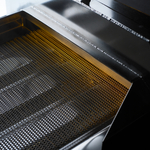Be still, my heart: the Jaguar E-Type is coming back—sort of.
By Automotive Editor

Three days ago, it was officially announced that the childhood dream car that I’ve never owned is returning. The Jaguar E-type is coming back—well, sort of.
And I almost missed the press release in my inbox.
But I finally found it, and my heart almost skipped a beat when I read it: Jaguar Classic confirmed on Thursday that they will offer all-electric E-Types for sale, branded as E-Type Zero to emphasize the zero-emissions profile of the powertrain.
The idea of an all-electric E-type was first teased as a concept car, shown at Jaguar Land Rover Tech Fest in September 2017.
“We’ve been overwhelmed by the positive reaction to the Jaguar E-Type Zero concept. Future-proofing the enjoyment of classic car ownership is a major stepping stone for Jaguar Classic,” said Jaguar Land Rover Classic Director Tim Hanning. “E-Type Zero showcases the incredible heritage of the E-Type, and the expertise and craftsmanship at Classic Works, while demonstrating Jaguar Land Rover’s dedication to creating zero emission vehicles across every part of the business, including Jaguar Classic.”
Granted, this reincarnation of the E-Type is a bit different from the return to brand-new production, announced earlier this year, of a very limited number of the Jaguar D-Type racer, a track-only vehicle built from 1954 through 1957, of which the E-Type was a road-going outgrowth.
No, Jaguar Classic is not going to actually build brand new all-electric E-Types from scratch. Instead, they will be building factory restorations of existing E-Types. They will be converted to an all-electric powertrain as part of the restoration process, and then offered for sale.
Using the technology that powers the current I-Pace, Jaguar’s award-winning all-electric, zero emissions SUV, Jaguar Classic will complete the restorations and powertrain conversions at their Jaguar Land Rover Classic Works facility, which also completes conventional-powertrain E-Type restorations under a branded program called E-Type Reborn.
In addition to restorations of E-Types that Jaguar Classic has sourced on their own, according to Thursday’s announcement a special electric-powertrain conversion program will also be offered to current E-Type owners. To ease possible resale-value concerns among collectors, Jaguar Classic notes that the conversion process will be reversible should an owner ever wish to return to the period-correct authenticity of an internal-combustion powertrain.
According to Jaguar Classic, the all-electric E-Types will drive and look like classic E-Types and offer “outstanding performance, with quicker acceleration than the original Series 1 E-Type.”
Travel range on a charge is targeted for more than 170 miles, which Jaguar Classic says is supported by the low curb weight (2,770-2,900 pounds for the roadster and coupe, and 3,090 for the 2+2) and aerodynamic body style of the Series 1 E-Type. Charging time for the 40 kwh battery is expected to be six to seven hours.
Jaguar Classic also said that the restored, electrified E-Types will feature modified instrumentation and fascia, with an up-to-date infotainment system available as an option. The E-Type’s signature inset headlight bays—one of the classic vehicle’s sexiest and ahead-of-its-time features—will be fitted with LED lamps.
In many ways, it’s a resto-mod dream—a like-new vintage classic equipped with all the latest technology.
Pricing, according to Jaguar Classic, is yet to be determined. In reality, this is, of course, probably going to be one of those “if you have to ask, don’t even bother” sorts of situations.
Am I going to be able to afford one when they come out?
Absolutely not.
If the price tag on the conventional powertrain E-Types that Jaguar Classic restores is any indication, the cost of an all-electric E-Type will be hefty indeed. According to an article that Road & Track published last year, prices for an E-Type Reborn restoration start at $335,000.
But that’s still a bargain compared to a 100%-new, factory-built internal-combustion Eagle E-Type replica, which, based on pricing information that Autocar published this year, would cost you nearly $835,000 at today’s exchange rates.
So it’s pretty clear that, if I ever get serious enough about putting my money where my mouth is and finally fulfilling my E-Type dream, I will be much better off buying a 60s or early-70s original.
Don’t be fooled by the prices you’ll see concours-quality E-Types going for when you’re watching something like live TV coverage of a Barrett-Jackson auction. Unlike the concours-quality, perfectly preserved, numbers-matching examples, reasonably well-sorted driver-quality E-Types from the 60s and early 70s are obtainable in a price range that is, theoretically, at least, accessible to me.
But it’s still good to know that, if I ever hit the Powerball or otherwise come into an a amount of money that’s all but unimaginable to me now, that the Jaguar E-Type is coming back and that a factory-restored, all-electric version just might be waiting for me.



